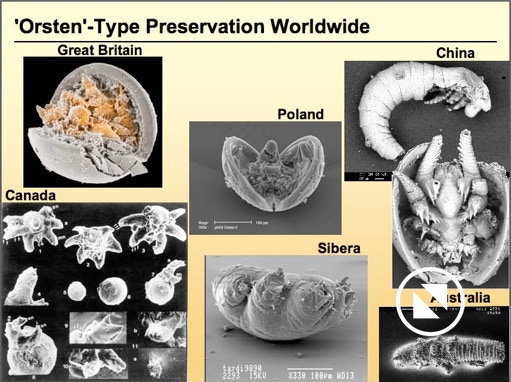In this Section...
The C.O.R.E. Group
Introduction
Scientific work on the 500 Million years old 'Orsten' fossils can serve an example of the fruitful alliance between Biology and Palaeontology, not least in order to improve our understanding of Metazoan evolution in general. Indeed, 'Orsten' fossils, now known from all around the World, have provided us with a unique window into life at the bottom of the Sea as early as in the Cambrian – and even in a three-dimensional view.
Occurrences around the world; more pictures, e.g., in our gallery of Orsten animals.
The international C.O.R.E. Group and its research activities
In 2005 a group of researchers, C.O.R.E. group, was founded as an informal international science alliance with a common interest in the exceptionally 3D preserved 'Orsten' fossils from the earliest period of the "Zoicum" (time of animal evidence), the Cambrian (ranging from 542 to 495 Million years before date). Until 2015 the number of members increased to around 40 from no less than 8 countries from 4 continents and Japan. The group consisted of the workgroup around Dieter Waloszek at the University of Ulm, several other workgroups such as in the UK and in Sweden, and single researchers. Study objects of C.O.R.E. were and still are in the main the 'Orsten' fossils, but also broader aspects of palaeobiology (from pale-environment and habitual aspects to all aspects of morphology, ontogeny [development] and functional morphology, to interrelationships and phylogeny or evolution in general), taphonomy and geology in general. One issue of the international research alliance was the concentration of expertise about the 'Orsten' and its fossils, 'Orsten' sites in which these occur, related topics, and, last but not least, the dissemination of information on the 'Orsten' as one of the most informative and significant early Palaeozoic lagerstaetten. To serve these purposes, a website ' was crated with simple tools, but with as much information as we could accumulate – corrected and updated as regular as possible. The C.O.R.E. 'Orsten' website was particularly built to present information about the 'Orsten' in geological terms and its fossils – mainly animals. Besides this, it also tried to provide some background data on the history of 'Orsten' research (from the founder to the activities today), methods and also relevant literature. We also started to present our first thoughts about more general aspects of the morphology, phylogeny and evolution of the animals, Metazoa.
The literature list included links to download underlying PDFs, but at that early time we ran out of webspace very soon. Updating was another problem. The new approach shall overcome this, but since the majority of papers (all from Dieter Waloszek) can be obtained or requested via the website of RESEARCH GATE, we shall only offer links to selected papers. E.g. those of the late Klaus J. Müller, which are not available otherwise.
What needs to be done with regard to the new 'Orsten' website is to update, correct and re-incorporate the old data, and, in the future, to add more information on 'Orsten' occurrences from other sites, particularly from China. These yielding not only the hitherto oldest fossils, but also uncovered the larges specimens in this type of preservation. Particularly the discoveries in China have contributed not only significantly to our knowledge about and around the 'Orsten' by adding different species, but they also added to our knowledge about lithological, preservational and taxonomical issues. More information will also be added on the localities from Newfoundland, UK, Poland, Siberia, and Australia. And of course we have to add information about the new methods applied in the after-Müller time. Altogether the 'Orsten' is the longest ranging type of conservat lagerstaetten, outranging Chengjiang from China – only early Cambrian – and Burgess Shale – only early to Middle Cambrian – by far: 'Orsten' fossils have become known from the early Cambrian to the latest Cambrian (Furongian), possibly extending even into the lower Ordovician!
Lastly, fossils from different localities in China, also of different age, and new investigations of material from Europe have provided us with new data on animals and groups that existing in the Cambrian, ca. 500 Million years ago. With this, they helped to improve and expand our knowledge and evolutionary interpretations significantly. This is also to tell that C.O.R.E. activities have continued and did not stop after a general agreement on a close-down of the website and the more initial research group. Several more recent articles deal with exceptionally preserved nemathelminth fossils, mainly scalidophorans, and their contribution to the knowledge of their life habits, their ontogeny and aspects of the phylogeny of this exciting group of predatorial worms. After Olempska et al. 2019 and their paper on a larval phosphatocopid from Poland, another article from 2019 depicts a larval phosphatocopid crustacean, this time from China (Liu et al. 2019). Furthermore, early this year 2020 a new article by Shao et al. appeared on a new scalidophoran from the Cambrian Fortunian Stage of South China and its implications for the origin and early evolution of Kinorhyncha. Accordingly, we are sure that Orsten research is continuing successfully.
© 2020 CORE



